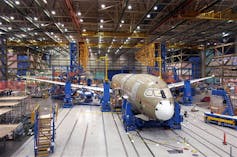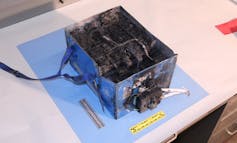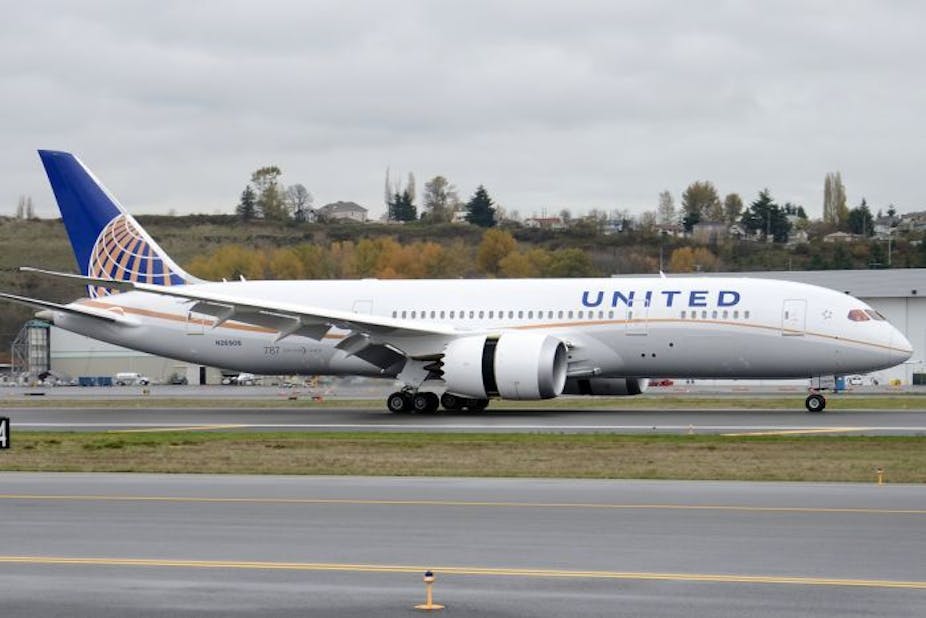This week, US civil aviation safety regulator, the Federal Aviation Administration (FAA) took the massive step of grounding all US Boeing 787 Dreamliners. Its equivalent European counterpart, the European Aviation Safety Agency (EASA), quickly followed suit.
The 787 Dreamliner has been facing some difficulties of late. Reported issues include a fuel leak, engine cracks, an oil leak, and a damaged cockpit window. The final straw came when a Japanese All Nippon Airways (ANA) 787 made an emergency landing in Japan after the aircraft’s lithium batteries overheated. Those on board reported a burning smell in the cabin.
Boeing 787 Dreamliner: first of its kind
In terms of technological advancement, the Boeing Dreamliner 787 is not an innovation, it’s a revolution.
As previously reported on The Conversation, the 787 is made primarily of composite materials. Both the Boeing 787 and the Airbus A350 feature more than 50% of composite materials (by weight) – the largest amount ever used on a commercial aircraft.

Compared to metals, composites offer better strength- and stiffness-to-weight ratio, better corrosion properties, and better fatigue resistance. By using composites, Boeing has significantly reduced the aircraft weight increasing its fuel efficiency by 20%.
By using carbon fibre composites, the plane can also be moulded back in single pieces during the assembly process. The manufacturing process relies on automated techniques (e.g. automated fibre placement) which provide increased accuracy and repeatability.
Initially, Boeing had to face a number of challenges with the use of composites. In 2008, the Australian Transport Safety Bureau (ATSB) investigated the challenges around composite materials capabilities and safety. In 2011, the US Government Accountability Office (GAO) released a report identifying concerns about the limited information on the behaviour of these new composite aircraft models. However, after years of being behind schedule, Boeing came through and received both FAA and EASA certification.
Another revolution in the making of the 787 Dreamliner is its power system. Indeed, part of the reason why the 787 is so light is that it relies far more than any other aircraft on electrical systems to function. Boeing opted for the use of lithium-ion batteries. However, it resulted in unanticipated issues.
More power, more problems
The main reason for the recent grounding resides in the use of lithion-ion batteries. These batteries generate a great amount of electrical power but they can also leak corrosive fluid and potentially start fires.
In the case of the ANA aircraft which prompted the grounding, electrolytes (a flammable battery fluid) were found to have leaked from the plane’s main lithium-ion battery and burn marks were found around the damage. It is reported that in the first battery incident (a JAL 787 auxiliary power unit caught fire), it took firefighters 40 minutes to put out the blaze.

Battery fluid is extremely corrosive and can damage electrical wiring and components. It is a main safety concern even though composite materials are more resistant to corrosion than aluminium.
Boeing’s chief engineering, Mike Sinnett, insisted that the plane’s batteries have operated through a combined 1.3 million hours and never had an internal fault.
Regulators: better be safe than sorry
The last time the FAA grounded an entire fleet was in 1979, when it grounded the DC-10 after a couple of fatal incidents: a Turkish Airlines DC-10 crashed over Paris in 1974 killing 346 people, and in 1979 an American Airlines DC-10 crashed during takeoff in Chicago resulting in 293 people killed.

Compared to the troubles experienced by the DC-10, FAA’s decision may seem excessive as the Dreamliner hasn’t crashed in its 15 months of service. But the revolutionary aspects in the 787 Dreamliner design and production prompted the agencies to take a closer a look and ground of the fleet.
These “teething” issues (i.e. problems that arise when a new aircraft is put into service) are not uncommon and experts expect them to be swiftly resolved. Fortunately, emergency procedure and built-in redundancies resulted in no lives being lost in the 787 incidents.
At this stage, it is up to the regulatory bodies to go in and have a look at the source and extent of the damage. It could be between two weeks and a couple of months before the fleet is allowed back in the air.
In the meantime, Qantas has cut its order of 15 Dreamliners by one but has said it is unrelated to the current issue.

